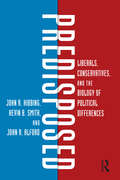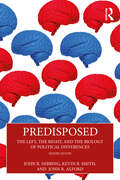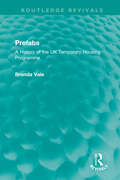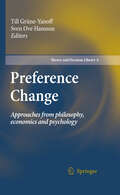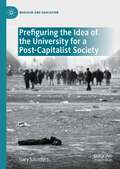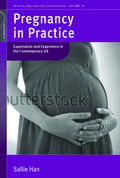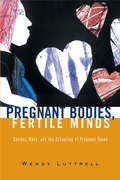- Table View
- List View
Predictive HR Analytics: Mastering the HR Metric
by Dr Martin Edwards Kirsten EdwardsHR metrics and organizational people-related data are an invaluable source of information from which to identify key trends and patterns in order to make effective business decisions. HR practitioners often, however, lack the statistical and analytical know-how to fully harness their potential. Predictive HR Analytics provides a clear, accessible framework with which to understand and work with people analytics and advanced statistical techniques. Step-by-step and by using worked examples, this book shows readers how to carry out and interpret analyses of various forms of HR data, such as employee engagement, performance and turnover, using the statistical packages SPSS (with R syntax provided), and, importantly, how to use the results to enable practitioners to develop effective evidence-based HR strategies.This second edition of Predictive HR Analytics has been updated to include new material on machine learning, biased algorithms, data protection and GDPR considerations, a new example using Kaplan Meier Survival analyses for tenure/turnover modelling and updated screenshots and examples with SPSS version 25. It is supported by a new appendix showing main R coding for the focal analyses approaches in the book, and online resources consisting of SPSS and Excel data sets and R syntax with worked case study examples.
Predictive HR Analytics: Mastering the HR Metric
by Dr Martin Edwards Kirsten Edwards Daisung JangThis is the essential guide for HR practitioners who want to gain the statistical and analytical knowledge to fully harness the potential of HR metrics and organizational people-related data.The ability to use and analyse data has become an invaluable skill for HR professionals to not only identify trends and patterns, but also make well-informed business decisions. The third edition of Predictive HR Analytics provides a clear, accessible framework for understanding people data, working with people analytics and advanced statistical techniques.Readers will be taken step-by-step through worked examples, showing them how to carry out analyses and interpret HR data in areas such as employee engagement, performance and turnover. Learn how to make effective business decision with this updated edition that includes the latest materials on predicting attrition with machine learning, biased algorithms and data protection, supported by online resources consisting of R and Excel data sets.
Predictive HR Analytics: Mastering the HR Metric
by Dr Martin Edwards Kirsten Edwards Daisung JangThis is the essential guide for HR practitioners who want to gain the statistical and analytical knowledge to fully harness the potential of HR metrics and organizational people-related data.The ability to use and analyse data has become an invaluable skill for HR professionals to not only identify trends and patterns, but also make well-informed business decisions. The third edition of Predictive HR Analytics provides a clear, accessible framework for understanding people data, working with people analytics and advanced statistical techniques.Readers will be taken step-by-step through worked examples, showing them how to carry out analyses and interpret HR data in areas such as employee engagement, performance and turnover. Learn how to make effective business decision with this updated edition that includes the latest materials on predicting attrition with machine learning, biased algorithms and data protection, supported by online resources consisting of R and Excel data sets.
Predictive Intelligence in Medicine: 5th International Workshop, PRIME 2022, Held in Conjunction with MICCAI 2022, Singapore, September 22, 2022, Proceedings (Lecture Notes in Computer Science #13564)
by Islem Rekik Ehsan Adeli Sang Hyun Park Celia CintasThis book constitutes the proceedings of the 5th International Workshop on Predictive Intelligence in Medicine, PRIME 2022, held in conjunction with MICCAI 2022 as a hybrid event in Singapore, in September 2022.The 19 papers presented in this volume were carefully reviewed and selected for inclusion in this book. The contributions describe new cutting-edge predictive models and methods that solve challenging problems in the medical field for a high-precision predictive medicine.
Predictive Intelligence in Medicine: Third International Workshop, PRIME 2020, Held in Conjunction with MICCAI 2020, Lima, Peru, October 8, 2020, Proceedings (Lecture Notes in Computer Science #12329)
by Islem Rekik Ehsan Adeli Sang Hyun Park Maria del C. Valdés HernándezThis book constitutes the proceedings of the Second International Workshop on Predictive Intelligence in Medicine, PRIME 2020, held in conjunction with MICCAI 2020, in Lima, Peru, in October 2020. The workshop was held virtually due to the COVID-19 pandemic. The 17 full and 2 short papers presented in this volume were carefully reviewed and selected for inclusion in this book. The contributions describe new cutting-edge predictive models and methods that solve challenging problems in the medical field for a high-precision predictive medicine.
Predisposed: Liberals, Conservatives, and the Biology of Political Differences
by John R. Hibbing Kevin B. Smith John R. AlfordBuried in many people and operating largely outside the realm of conscious thought are forces inclining us toward liberal or conservative political convictions. Our biology predisposes us to see and understand the world in different ways, not always reason and the careful consideration of facts. These predispositions are in turn responsible for a significant portion of the political and ideological conflict that marks human history. With verve and wit, renowned social scientists John Hibbing, Kevin Smith, and John Alford—pioneers in the field of biopolitics—present overwhelming evidence that people differ politically not just because they grew up in different cultures or were presented with different information. Despite the oft-heard longing for consensus, unity, and peace, the universal rift between conservatives and liberals endures because people have diverse psychological, physiological, and genetic traits. These biological differences influence much of what makes people who they are, including their orientations to politics. Political disputes typically spring from the assumption that those who do not agree with us are shallow, misguided, uninformed, and ignorant. Predisposed suggests instead that political opponents simply experience, process, and respond to the world differently. It follows, then, that the key to getting along politically is not the ability of one side to persuade the other side to see the error of its ways but rather the ability of each side to see that the other is different, not just politically, but physically. Predisposed will change the way you think about politics and partisan conflict. As a bonus, the book includes a "Left/Right 20 Questions" game to test whether your predispositions lean liberal or conservative.
Predisposed: Liberals, Conservatives, and the Biology of Political Differences
by John R. Hibbing Kevin B. Smith John R. AlfordBuried in many people and operating largely outside the realm of conscious thought are forces inclining us toward liberal or conservative political convictions. Our biology predisposes us to see and understand the world in different ways, not always reason and the careful consideration of facts. These predispositions are in turn responsible for a significant portion of the political and ideological conflict that marks human history. With verve and wit, renowned social scientists John Hibbing, Kevin Smith, and John Alford—pioneers in the field of biopolitics—present overwhelming evidence that people differ politically not just because they grew up in different cultures or were presented with different information. Despite the oft-heard longing for consensus, unity, and peace, the universal rift between conservatives and liberals endures because people have diverse psychological, physiological, and genetic traits. These biological differences influence much of what makes people who they are, including their orientations to politics. Political disputes typically spring from the assumption that those who do not agree with us are shallow, misguided, uninformed, and ignorant. Predisposed suggests instead that political opponents simply experience, process, and respond to the world differently. It follows, then, that the key to getting along politically is not the ability of one side to persuade the other side to see the error of its ways but rather the ability of each side to see that the other is different, not just politically, but physically. Predisposed will change the way you think about politics and partisan conflict. As a bonus, the book includes a "Left/Right 20 Questions" game to test whether your predispositions lean liberal or conservative.
Predisposed: The Left, The Right, and the Biology of Political Differences
by John R. Hibbing Kevin B. Smith John R. AlfordThis thoughtfully updated revision of a classic text sheds new light on the potential sociological and biological differences that result in deep, seemingly unbridgeable political divisions.Renowned social scientists and experts in biopolitics, John R. Hibbing, Kevin B. Smith, and John R. Alford present overwhelming evidence that political opinion is shaped not just by cultural background or information bias but is rather the result of diverse psychological, physiological, and genetic traits. This new edition shifts the emphasis from differences between the political left and the right (liberals and conservatives) as they have traditionally been understood and explores specific brands of liberalism and conservatism such as ardent supporters of politicians such as Donald Trump.An essential read for students and scholars of political psychology and party politics, this book invites the reader to reconsider their perspectives on public opinion and partisan conflict.
Predisposed: The Left, The Right, and the Biology of Political Differences
by John R. Hibbing Kevin B. Smith John R. AlfordThis thoughtfully updated revision of a classic text sheds new light on the potential sociological and biological differences that result in deep, seemingly unbridgeable political divisions.Renowned social scientists and experts in biopolitics, John R. Hibbing, Kevin B. Smith, and John R. Alford present overwhelming evidence that political opinion is shaped not just by cultural background or information bias but is rather the result of diverse psychological, physiological, and genetic traits. This new edition shifts the emphasis from differences between the political left and the right (liberals and conservatives) as they have traditionally been understood and explores specific brands of liberalism and conservatism such as ardent supporters of politicians such as Donald Trump.An essential read for students and scholars of political psychology and party politics, this book invites the reader to reconsider their perspectives on public opinion and partisan conflict.
Prefabs: A History of the UK Temporary Housing Programme (Routledge Revivals)
by Brenda ValeOriginally published in 1995, this book unravels the history of the ‘temporary bungalow’ and shows that perhaps it was more a question of providing a new peace-time product for factories than a means of providing accommodation for the homeless. Built in a period of housing history which remains fascinating for architects and planners and admired by some of their first occupants but berated by others, those prefabs remaining today are subject to preservation orders but also perhaps offer a solution to the ongoing housing crisis in the UK. The book includes chapters on the development of the prefab house in the UK; comparisons with temporary housing programmes in the USA, Sweden and Germany; political and economic considerations to the UK Temporary Housing Programme and a discussion of the design of the Arcon, Uni-Seco, Tarran and Aluminium Temporary Bungalows.
Prefabs: A History of the UK Temporary Housing Programme (Routledge Revivals)
by Brenda ValeOriginally published in 1995, this book unravels the history of the ‘temporary bungalow’ and shows that perhaps it was more a question of providing a new peace-time product for factories than a means of providing accommodation for the homeless. Built in a period of housing history which remains fascinating for architects and planners and admired by some of their first occupants but berated by others, those prefabs remaining today are subject to preservation orders but also perhaps offer a solution to the ongoing housing crisis in the UK. The book includes chapters on the development of the prefab house in the UK; comparisons with temporary housing programmes in the USA, Sweden and Germany; political and economic considerations to the UK Temporary Housing Programme and a discussion of the design of the Arcon, Uni-Seco, Tarran and Aluminium Temporary Bungalows.
Preference Change: Approaches from philosophy, economics and psychology (Theory and Decision Library A: #42)
by Till Grüne-Yanoff Sven Ove HanssonChanging preferencesis a phenomenonoften invoked but rarely properlyaccounted for. Throughout the history of the social sciences, researchers have come against the possibility that their subjects’ preferenceswere affected by the phenomenato be explainedor by otherfactorsnot taken into accountin the explanation.Sporadically, attempts have been made to systematically investigate these in uences, but none of these seems to have had a lasting impact. Today we are still not much further with respect to preference change than we were at the middle of the last century. This anthology hopes to provide a new impulse for research into this important subject. In particular, we have chosen two routes to amplify this impulse. First, we stress the use of modellingtechniquesfamiliar from economicsand decision theory. Instead of constructing complex, all-encompassing theories of preference change, the authors of this volume start with very simple, formal accounts of some possible and hopefully plausible mechanism of preference change. Eventually, these models may nd their way into larger, empirically adequate theories, but at this stage, we think that the most importantwork lies in building structure.Secondly,we stress the importance of interdisciplinary exchange. Only by drawing together experts from different elds can the complex empirical and theoretical issues in the modelling of preference change be adequately investigated.
Preference Pollution: How Markets Create the Desires We Dislike (Economics, Cognition, And Society)
by David GeorgeSeldom considered is whether markets do an adequate job of shaping our tastes. David George argues that they do not, and that the standard economic definition of efficiency can be used to demonstrate that the market ignores people's desires about their desires. He concludes that markets perform poorly with respect to second-order preferences, thus worsening the problem of undesired desires. The book further investigates changes in perceptions and public policy toward such activities as gambling, credit, entertainment, and sexual behavior. David George is Chair and Professor Economics, LaSalle University.
Prefiguring the Idea of the University for a Post-Capitalist Society (Marxism and Education)
by Gary SaundersUsing an Open Marxist theoretical framework, this book provides a critique of the neoliberal reforms made to higher education since the late 1970s and the impact this has had on the sector. Rather than arguing for a return to the idea of the public university, the book argues that public and private models of higher education are both forms of capitalist accumulation and have historically perpetuated forms of oppression, exploitation and discrimination; thus, a more radical solution that addresses both the current crisis of higher education and the contradictory and exploitative nature of late capitalism is required. This book critically examines the autonomous learning spaces that emerged out of the UK student protests (2009-2010) and documents what can be learned from them to prefigure the idea of the university for a post-capitalist society.
Pregnancy in Practice: Expectation and Experience in the Contemporary US (Fertility, Reproduction and Sexuality: Social and Cultural Perspectives #25)
by Sallie HanBabies are not simply born—they are made through cultural and social practices. Based on rich empirical work, this book examines the everyday experiences that mark pregnancy in the US today, such as reading pregnancy advice books, showing ultrasound “baby pictures” to friends and co-workers, and decorating the nursery in anticipation of the new arrival. These ordinary practices of pregnancy, the author argues, are significant and revealing creative activities that produce babies. They are the activities through which babies are made important and meaningful in the lives of the women and men awaiting the child’s birth. This book brings into focus a topic that has been overlooked in the scholarship on reproduction and will be of interest to professionals and expectant parents alike.
Pregnancy Outcomes of Unmarried Women in Japan: From Abortion to Birth (SpringerBriefs in Population Studies)
by Yukiko SendaThis book provides a key to understanding why there was an increase in extra-marital fertility in Japan from the 1990s to the 2010s, particularly between 1995 and 2015, and the factors which contribute to the multistratification of unmarried mothers, the number of which has increased ensuingly. It also allows for international comparison by providing data on outcomes of extra-marital childbirth. Previously, it was believed that the idea of a ‘second demographic transition’ did not apply to Japan, which had a relatively low rate of extra-marital fertility. However, more recently, though still at a low level, a subtle but gradual rise is seen in the number of women who become unmarried mothers as a result of births outside marriage. This trend suggests that the social environment surrounding pregnancy, childbirth, and marriage is changing. In this book, various data such as national statistics, nationwide surveys, and media discourse are analysed with a view to revealing the factors affecting unmarried women’s decisions when they discover they are pregnant. Various matters are discussed, such as changes in sexual activity and contraceptive use, advance in reproductive technology, the law and government policies pertaining to adoption, social consciousness towards unwed mothers, the change in perception of abortion from the religious perspective, and difference of socioeconomic status depending on the women’s occupation. Facts from vital statistics are first laid out, showing that, while abortion has consistently been on the decrease from the 1990s onward, shotgun marriages have peaked out. Adoption is rare and remains very small in proportion, while extra-marital fertility is on the rise. The author then points to the possibility that greater lenience found in the social consciousness towards unwed mothers in recent years is a pull factor for the increase in extra-marital fertility. Further, by analysing vital statistics, it is revealed that the probability of becoming a mother without marrying changed with the woman’s occupation, explicable by the stability of employment and level of income, and that between 1995 and 2015, the effects of the job factor are changing. If we assume that, unlike the first demographic transition model, the ‘second demographic transition’ may show a similar direction but be on a different scale according to the country, it is possible to say that Japan too is experiencing the ‘second demographic transition’.
Pregnancy, Risk and Biopolitics: On the Threshold of the Living Subject (Transformations)
by Lorna WeirTraditionally, Euroamerican cultures have considered that human status was conferred at the conclusion to childbirth. However, in contemporary Euroamerican biomedicine, law and politics, the living subject is often claimed to pre-exist birth. In this fascinating book Lorna Weir argues that the displacement of birth as the threshold of the living subject began in the 1950s with the novel concept of ‘perinatal mortality’ referring to death of either the foetus or the newborn just prior to, during or after birth. Weir’s book gives a new feminist approach to pregnancy in advanced modernity focusing on the governance of population. She traces the introduction of the perinatal threshold into child welfare and tort law through expert testimony on foetal risk, sketching the clash at law between the birth and perinatal thresholds of the living subject. Her book makes original empirical and theoretical contributions to the history of the present (Foucauldian research), feminism, and social studies of risk, and she conceptualizes a new historical focus for the history of the present: the threshold of the living subject. Calling attention to the significance of population politics, especially the reduction of infant mortality, for the unsettling of the birth threshold, this book argues that risk techniques are heterogeneous, contested with expertise, and plural in their political effects. Interview research with midwives shows their critical relation to using risk assessment in clinical practice. An original and accessible study, this book will be of great interest to students and researchers across many disciplines.
Pregnancy, Risk and Biopolitics: On the Threshold of the Living Subject (Transformations)
by Lorna WeirTraditionally, Euroamerican cultures have considered that human status was conferred at the conclusion to childbirth. However, in contemporary Euroamerican biomedicine, law and politics, the living subject is often claimed to pre-exist birth. In this fascinating book Lorna Weir argues that the displacement of birth as the threshold of the living subject began in the 1950s with the novel concept of ‘perinatal mortality’ referring to death of either the foetus or the newborn just prior to, during or after birth. Weir’s book gives a new feminist approach to pregnancy in advanced modernity focusing on the governance of population. She traces the introduction of the perinatal threshold into child welfare and tort law through expert testimony on foetal risk, sketching the clash at law between the birth and perinatal thresholds of the living subject. Her book makes original empirical and theoretical contributions to the history of the present (Foucauldian research), feminism, and social studies of risk, and she conceptualizes a new historical focus for the history of the present: the threshold of the living subject. Calling attention to the significance of population politics, especially the reduction of infant mortality, for the unsettling of the birth threshold, this book argues that risk techniques are heterogeneous, contested with expertise, and plural in their political effects. Interview research with midwives shows their critical relation to using risk assessment in clinical practice. An original and accessible study, this book will be of great interest to students and researchers across many disciplines.
Pregnant Bodies, Fertile Minds: Gender, Race, and the Schooling of Pregnant Teens
by Wendy LuttrellFocusing on fifty girls enrolled in a model public school program for pregnant teens, Luttrell explores how pregnant girls experience society's view of them and also considers how these girls view themselves and the choices they've made. Also includes an 8-page color insert.
Pregnant Bodies, Fertile Minds: Gender, Race, and the Schooling of Pregnant Teens
by Wendy LuttrellFocusing on fifty girls enrolled in a model public school program for pregnant teens, Luttrell explores how pregnant girls experience society's view of them and also considers how these girls view themselves and the choices they've made. Also includes an 8-page color insert.
Prehistoric Warfare and Violence: Quantitative and Qualitative Approaches (Quantitative Methods in the Humanities and Social Sciences)
by Andrea Dolfini Rachel J. Crellin Christian Horn Marion UckelmannThis is the first book to explore prehistoric warfare and violence by integrating qualitative research methods with quantitative, scientific techniques of analysis such as paleopathology, morphometry, wear analysis, and experimental archaeology. It investigates early warfare and violence from the standpoint of four broad interdisciplinary themes: skeletal markers of violence and weapon training; conflict in prehistoric rock-art; the material culture of conflict; and intergroup violence in archaeological discourse. The book has a wide-ranging chronological and geographic scope, from early Neolithic to late Iron Age and from Western Europe to East Asia. It includes world-renowned sites and artefact collections such as the Tollense Valley Bronze Age battlefield (Germany), the UNESCO World Heritage Site at Tanum (Sweden), and the British Museum collection of bronze weaponry from the late Shang period (China). Original case studies are presented in each section by a diverse international authorship.The study of warfare and violence in prehistoric and pre-literate societies has been at the forefront of archaeological debate since the publication of Keeley’s provocative monograph ‘War Before Civilization’ (Oxford 1996). The problem has been approached from a number of standpoints including anthropological and behavioural studies of interpersonal violence, osteological examinations of sharp lesions and blunt-force traumas, wear analysis of ancient weaponry, and field experiments with replica weapons and armour. This research, however, is often confined within the boundaries of the various disciplines and specialist fields. In particular, a gap can often be detected between the research approaches grounded in the humanities and social sciences and those based on the archaeological sciences. The consequence is that, to this day, the subject is dominated by a number of undemonstrated assumptions regarding the nature of warfare, combat, and violence in non-literate societies. Moreover, important methodological questions remain unanswered: can we securely distinguish between violence-related and accidental trauma on skeletal remains? To what extent can wear analysis shed light on long-forgotten fighting styles? Can we design meaningful combat tests based on historic martial arts? And can the study of rock-art unlock the social realities of prehistoric warfare? By breaking the mould of entrenched subject boundaries, this edited volume promotes interdisciplinary debate in the study of prehistoric warfare and violence by presenting a number of innovative approaches that integrate qualitative and quantitative methods of research and analysis.
Prehistoric Warfare on the Great Plains: Skeletal Analysis of the Crow Creek Massacre Victims (Evolution of North American Indians Series)
by P. WilleyFirst Published in 1991.This study is the product of the discovery, excavation, processing, data collection and analysis of nearly 500 human skeletons from the Crow Creek Massacre Project, South Dakota. In about 1325 AD nearly 500 American Indians were massacred, and their remains were discovered, excavated and cleaned in 1978. The general purpose of the Crow Creek osteological study were to describe the remains as fully as time permitted and compare these results with other samples. This volume presents information concerning the Crow Creek bone elements, paleodemography, cranial affiliations, mutilations and stature. It emphasizes the unique feature of the sample and compares the Crow Creek sample with other skeletal samples from the Plains.
Prehistoric Warfare on the Great Plains: Skeletal Analysis of the Crow Creek Massacre Victims (Evolution of North American Indians Series)
by P. WilleyFirst Published in 1991.This study is the product of the discovery, excavation, processing, data collection and analysis of nearly 500 human skeletons from the Crow Creek Massacre Project, South Dakota. In about 1325 AD nearly 500 American Indians were massacred, and their remains were discovered, excavated and cleaned in 1978. The general purpose of the Crow Creek osteological study were to describe the remains as fully as time permitted and compare these results with other samples. This volume presents information concerning the Crow Creek bone elements, paleodemography, cranial affiliations, mutilations and stature. It emphasizes the unique feature of the sample and compares the Crow Creek sample with other skeletal samples from the Plains.
Preiserhöhungen verkaufen: Wie Sie auch mit höheren Preisen keine Kunden verlieren
by Jeb BlountPreiserhöhungsinitiativen - ob auf breiter Basis oder auf bestimmte Kunden ausgerichtet - machen den meisten den Vertriebsprofis und Kundenbetreuern, die sie ihren Kunden verkaufen sollen, Angst. Preiserhöhungen bei Kunden stehen ganz oben auf der Liste der Dinge, die Vertriebsmitarbeiter ungern tun, weil sie befürchten, dass Preiserhöhungen das Verkaufsvolumen verringern oder der Konkurrenz die Tür öffnen. Doch wenn man effektiv verkauft, akzeptieren die Kunden Preiserhöhungen, bleiben loyal und kaufen oft sogar mehr. In seinem neuen Buch zeigt der bekannte Verkaufstrainer Jeb Blount die Strategien, Taktiken, Techniken und Rahmenbedingungen auf, mit denen Verkäufer Preiserhöhungsinitiativen erfolgreich meistern können. Von der Ausarbeitung wirksamer Preiserhöhungsbotschaften über den Schutz hart erkämpfter Beziehungen und den Umgang mit gängigen Einwänden bis hin zur Argumentation für den von ihnen gebotenen Wert führt dieser umfassende Leitfaden Vertriebsmitarbeiter durch jeden Schritt des Verkaufsprozesses für Preiserhöhungen. In jedem Kapitel finden die Leser praktische Übungen, die ihnen helfen, das System "Preiserhöhung verkaufen" zu beherrschen. Mit jedem neuen Kapitel werden sie mehr und mehr Vertrauen in ihre Fähigkeit gewinnen, Kunden erfolgreich in Preiserhöhungsgespräche einzubeziehen. Das Buch ist ein unverzichtbares Handbuch für Vertriebsprofis, Kundenbetreuer, Kundenerfolgsteams und andere Führungskräfte im Bereich der Umsatzgenerierung, die einen spannenden und aufschlussreichen Leitfaden für die Navigation durch die wichtige - und nervenaufreibende - Welt der Preiserhöhungen suchen.




